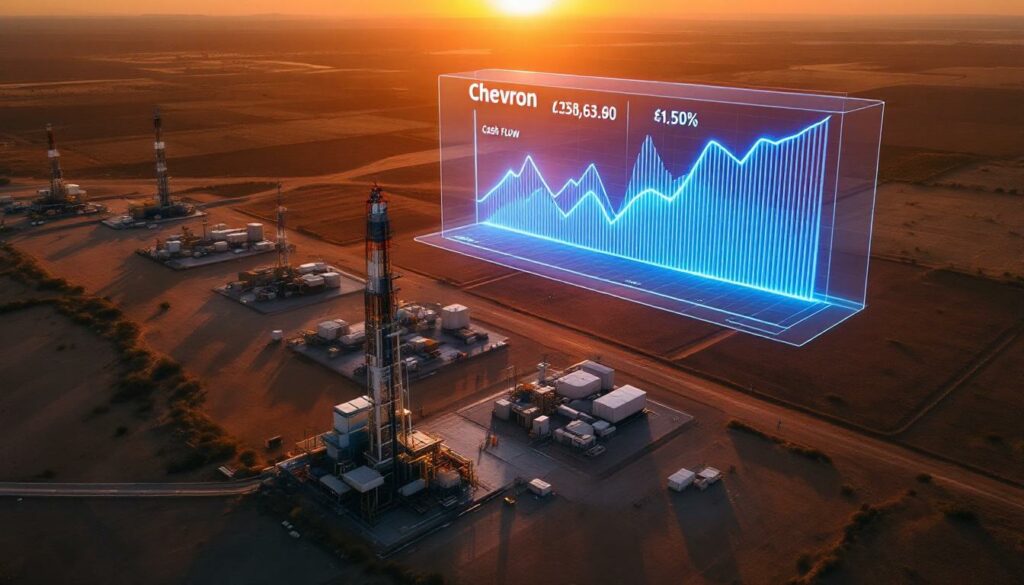How Does Chevron's Cash Flow Strategy in the Permian Differ from Competitors?
Chevron has fundamentally reshaped its approach to the Permian Basin, breaking from industry norms by prioritizing sustainable cash generation over aggressive production growth. Unlike many competitors who measure success by barrels produced, Chevron evaluates performance through financial metrics like return on capital employed (ROCE) and free cash flow (FCF).
With 2.2 million net acres in the Permian Basin—the largest position among major oil companies—Chevron operates with remarkable financial discipline. While many competitors target 5-10% annual production growth, Chevron maintains a measured 3% annual growth rate through 2025, focusing instead on generating superior returns from each barrel.
"We prioritize returns over volume. Every Permian dollar spent must compete globally for capital." – Mike Wirth, Chevron CEO
This disciplined approach has yielded impressive results. Chevron's Permian operations achieve break-even costs of $30-$40 per barrel, significantly below the industry average of $45-$55. This cost advantage provides resilience during market downturns and exceptional profitability during stronger oil price movements.
The company's "cube development" methodology—which clusters wells in geologically contiguous zones—has reduced drilling time and costs by approximately 15% according to industry analysis. This stands in stark contrast to competitors who often prioritize headline production numbers over operational efficiency.
A telling comparison: Chevron slashed 2020-2022 Permian capital expenditures by 50% while maintaining output levels. During the same period, several competitors like Pioneer Resources boosted production by 12% but generated negative free cash flow. The difference in philosophy couldn't be clearer—Chevron focuses on shareholder returns while many peers chase production growth.
What Is Driving Chevron's Cash Flow-First Approach in the Permian?
Economic Fundamentals Reshaping Strategy
Chevron's strategic pivot isn't happening in isolation—it reflects profound changes in energy market dynamics and investor expectations. The company recognized earlier than most that Wall Street now values predictable returns over production records.
According to proxy vote disclosures, 92% of Chevron's top 20 shareholders have explicitly demanded share buybacks and dividends rather than production growth. This investor pressure has become impossible to ignore, especially as ESG-focused funds increase their influence in the sector.
"The 'growth at all costs' model is dead. Markets punish unprofitable barrels now." – Biraj Borkhataria, RBC Capital Markets
Investor Pressure for Capital Discipline
Institutional investors, burned by years of disappointing returns from shale producers, have dramatically shifted their expectations. They now demand:
- Consistent and growing dividend payments
- Substantial share buyback programs
- Reduced capital expenditures
- Improved return on invested capital (ROIC)
- Lower debt-to-EBITDA ratios (Chevron: 0.9x vs. industry average: 1.8x)
This investor revolt against unprofitable growth has reshaped Chevron's decision-making. The company now enforces capital discipline through a "tiered inventory economics" system where only Tier 1 locations (those with >20% internal rate of return) receive drilling approval.
Lessons from Past Industry Mistakes
The shale sector's history is littered with cautionary tales. Between 2020-2023, Permian producers wrote down an astonishing $120 billion in assets through bankruptcies and impairments. Companies like Whiting Petroleum exemplified the dangers of debt-fueled growth strategies.
Chevron studied these failures carefully and determined that sustainable cash generation provides greater long-term value than pursuing maximum output. By avoiding the debt trap that ensnared so many competitors, Chevron maintained financial flexibility during downturns and capitalized on acquisition opportunities when distressed assets became available.
How Is Chevron Implementing Its Cash Flow Strategy?
Selective Development Approach
Rather than developing all available acreage simultaneously, Chevron employs a measured approach that maximizes returns while maintaining long-term reservoir health:
- Prioritizes "core of the core" drilling locations with superior economics
- Implements optimal well spacing to prevent interference issues that have plagued competitors
- Sequences development to fully utilize infrastructure, reducing capital intensity
- Maintains significant flexibility to adjust to changing market conditions
This disciplined approach stands in contrast to operators who have drilled aggressively, only to discover that excessive well density creates interference problems that reduce per-well productivity and overall returns.
Cost Control Initiatives
Chevron has implemented comprehensive cost management across its Permian operations:
- Pad drilling: Deploying 12-16 wells per pad (vs. industry average of 8-10), reducing costs by approximately $200,000 per well
- Standardized well designs: Capturing economies of scale and reducing design time
- Integrated supply chain management: Creating leverage with service providers through consistent activity levels
- Multi-well pad development: Minimizing surface footprint while maximizing operational efficiency
- Advanced data analytics: Reducing drilling downtime by 23% compared to previous practices
These cost control initiatives have transformed Chevron's Permian operations into a model of efficiency, with production costs averaging $10.50 per barrel versus the Permian average of $15.20.
Technology Deployment for Efficiency
Chevron leverages cutting-edge technology to enhance productivity throughout its Permian operations:
"Our AI models predict subsurface bottlenecks 30 days out, optimizing completions in real time." – Balaji Krishnamurthy, Chevron CTO
The company has deployed digital twin technology that simulates reservoir performance using real-time fiber-optic sensors. This allows engineers to optimize well placement and completion designs with unprecedented precision.
In one Midland Basin project, AI-directed drilling boosted estimated ultimate recovery (EUR) per well by 18% compared to conventional approaches. The company's supply chain optimization initiatives alone saved approximately $380 million annually, according to recent reports.
What Financial Benefits Does This Strategy Deliver?
Enhanced Free Cash Flow Generation
By prioritizing efficiency over raw growth, Chevron has transformed its Permian operations into a free cash flow powerhouse:
- 2024 FCF: $21 billion (compared to $9 billion in 2019)
- Permian contribution: 35% of total corporate free cash flow
- Break-even price: Substantially below many competitors, providing resilience during downturns
- Cash margins: Doubled over five years by focusing on high-quality development
This robust cash generation provides Chevron with strategic flexibility that many competitors lack. During the 2023 oil price slump (below $50/barrel), Chevron maintained its dividend while several peers were forced to cut payouts or increase debt.
Shareholder Return Mechanisms
Chevron's cash flow-focused strategy has enabled exceptional shareholder returns:
- Share repurchases: $10 billion in 2024
- Dividend payments: $11 billion in 2024, with consistent growth of 6% annually since 2021
- Debt reduction: $15 billion eliminated between 2020-2024
- Dividend yield: Approximately 4%, combining income with inflation protection
"Chevron is a bond proxy hiding in an energy stock – 4% yield with inflation protection." – Jennifer Rowland, JP Morgan Energy Analyst
This balanced approach to capital allocation has earned Chevron a premium valuation compared to most peers, reflecting investor confidence in the sustainability of its strategy.
Investment Flexibility
Strong cash generation provides Chevron with strategic optionality:
- Energy transition investments: $10 billion allocated for 2023-2028, funded by Permian cash flow
- Low-carbon projects: Including a blue hydrogen pilot in the Midland Basin planned for 2026
- Carbon capture initiatives: $3.2 billion CCS project funded via Permian free cash flow
- Opportunistic acquisitions: Financial strength to pursue value-accretive deals when available
This flexibility allows Chevron to navigate both short-term market volatility and long-term energy transition challenges without compromising shareholder returns.
How Does Chevron's Approach Compare to Industry Peers?
Contrasting Development Philosophies
While Chevron emphasizes sustainable returns, many competitors continue to prioritize production growth:
- Private equity-backed operators: Often focus on short-term production increases to position assets for sale
- Public independents: Many still emphasize reserves replacement and production growth to attract investors
- National oil companies: Frequently prioritize market share regardless of returns
This philosophical difference has led to measurably different outcomes. For example, in 2024, Diamondback Energy pursued 15% volume growth but generated negative free cash flow, while Chevron achieved modest 2% growth but produced $7 billion in free cash flow.
Financial Performance Metrics
The numbers clearly demonstrate the advantages of Chevron's approach:
- Return on capital employed (ROCE): Chevron 12% vs. Exxon 9%, Occidental 6%
- Production costs per barrel: Chevron $10.50 vs. Permian average $15.20
- Debt-to-EBITDA ratios: Chevron 0.9x vs. industry average 1.8x
- Share price performance: Superior long-term returns with lower volatility
These metrics reveal that Chevron's focus on efficiency and returns has created a more financially robust operation than many competitors who prioritize production volume.
Long-term Sustainability Advantages
Chevron's measured approach positions it better for future challenges:
- Environmental performance: Methane intensity of 0.08% vs. basin average of 0.15%
- Water management: Using 1.2 barrels of water per barrel of oil vs. industry standard of 1.8 barrels
- ESG investor appeal: 28% of institutional holders are ESG-mandated funds
- Carbon pricing readiness: Lower-cost operations provide buffer against potential carbon taxes
These sustainability advantages are increasingly important as environmental considerations gain prominence in investment opportunities 2025.
What Are the Implications for Permian Basin Production?
Moderated Growth Trajectory
Chevron's approach suggests a more measured production growth curve for its Permian assets:
- Growth rate: <3% annually (2025-2030) vs. historical basin average of 12%
- Inventory depth: 15-year supply of Tier 1 locations at $50 oil
- Field longevity: Extended productive life through optimal development
- Well performance: 25% slower first-year decline rates than basin average
This moderated growth approach prevents the premature reservoir depletion that has plagued many operators who pursued aggressive early production.
"Moderated growth extends field life to 2050+ and avoids Midland Basin's parent-child well damage." – Scott Sheffield, ex-Pioneer CEO
Reservoir modeling shows that unconstrained development can reduce estimated ultimate recovery by up to 40% in core zones, highlighting the long-term benefits of Chevron's disciplined approach.
Infrastructure and Capacity Planning
Chevron's measured development pace enables more efficient infrastructure investment:
- Gas capture rate: 95% vs. basin average of 88%, reducing flaring and emissions
- Pipeline planning: Coordinated development to avoid bottlenecks and price discounts
- Processing capacity: Right-sized facilities that maintain high utilization rates
- Water management: Integrated systems that maximize recycling and minimize freshwater use
This coordinated approach to infrastructure development reduces capital intensity and environmental impact while enhancing overall returns.
Environmental and Community Impact
Beyond financial returns, Chevron's measured approach yields broader benefits:
- Reduced emissions: Lower flaring through planned infrastructure development
- Water conservation: Advanced recycling systems minimize freshwater consumption
- Community investment: $120 million in New Mexico road projects (2023-2025)
- Stable employment: Consistent activity levels support sustainable local economies
These positive externalities strengthen Chevron's social license to operate in a sector facing increasing scrutiny from stakeholders.
How Might This Strategy Evolve in a Changing Energy Landscape?
Adaptation to Price Volatility
Chevron's cash flow-first approach provides exceptional flexibility to navigate market fluctuations:
- Activity modulation: During the 2020 downturn, Chevron reduced Permian rigs from 30 to 8, then restored to 20 in 2022 as prices recovered
- Inventory preservation: High-grading ensures best locations remain available for future development
- Hedging strategy: 50% of 2025 output has price floors at $55/barrel
- Financial resilience: Low debt provides buffer during downturns
This flexibility allows Chevron to adjust capital allocation rapidly as market conditions change, maintaining profitability across price cycles.
Energy Transition Considerations
The strategy positions Chevron to address evolving energy demands:
- Transition funding: Permian cash flow supports $10 billion in low-carbon investments (2023-2028)
- Carbon capture: Technology deployment to reduce emissions intensity
- Portfolio balance: Ability to adjust development pace as energy mix evolves
- Asset longevity: Focus on lowest-cost, lowest-carbon barrels that remain competitive
"Our Permian cash engine lets us pivot to hydrogen/CCS without stranded assets." – Jeff Gustavson, Chevron New Energies VP
By generating substantial free cash flow, Chevron can fund energy transition initiatives while maintaining shareholder returns—a balancing act many competitors struggle to achieve.
Technological Innovation Opportunities
Strong cash generation enables continued investment in productivity-enhancing technologies:
- Machine learning applications: Optimizing drilling parameters and completion designs
- Artificial intelligence: Predictive maintenance to minimize downtime
- Digital transformation: Real-time data integration across operations
- Emissions reduction technology: Methane detection and mitigation systems
These technological investments create a virtuous cycle—improved efficiency generates more cash flow, which funds further innovation.
What Does This Mean for Investors?
Investment Thesis Evolution
Chevron's strategy reflects a fundamental shift in how oil companies position themselves to investors:
- From production growth to cash generation: Measuring success by financial returns rather than barrels
- From reserve replacement to capital efficiency: Focusing on value rather than volume
- From market share competition to disciplined allocation: Deploying capital only to highest-return opportunities
- From commodity exposure to total shareholder return: Balancing dividends, buybacks, and growth
This evolution addresses investor demands for more predictable returns and greater financial discipline.
Risk Profile Changes
The cash flow-first approach has transformed Chevron's risk profile:
- Reduced financial leverage: Lower debt levels provide resilience during downturns
- Operational flexibility: Ability to adjust activity levels as conditions warrant
- Price sensitivity: Break-even levels well below most forecasted price scenarios
- Energy transition readiness: Financial capacity to adapt to changing markets
For investors, this translates to lower volatility and more consistent returns compared to companies with higher operational and financial leverage.
Long-term Value Proposition
For long-term investors, Chevron's strategy offers compelling advantages:
- Sustainable dividend growth: 6% annual increases supported by strong free cash flow
- Share count reduction: Ongoing buyback program enhances per-share metrics
- ESG compatibility: Improved environmental performance attracts sustainability-focused funds
- Energy transition positioning: Balanced approach to evolving energy landscape
This value proposition has attracted a diverse investor base, with 28% of institutional holders now being ESG-mandated funds according to recent Morningstar data.
FAQ: Chevron's Permian Basin Strategy
How does Chevron's Permian acreage position compare to competitors?
Chevron holds approximately 2.2 million net acres in the Permian Basin, making it one of the largest acreage holders in the region. More importantly, approximately 80% of this acreage is classified as "core" (top 20% ROI tier) according to Enverus analysis. This premium position spans both the Delaware and Midland sub-basins, providing decades of high-quality drilling inventory.
What production targets has Chevron established for its Permian operations?
Rather than focusing solely on production targets, Chevron emphasizes sustainable development that optimizes returns. The company targets Permian production of approximately 800,000 barrels of oil equivalent per day by 2025, representing modest growth of less than 3% annually. This measured approach contrasts with some competitors pursuing double-digit growth rates despite concerns about US drilling activity trends.
"Our Permian wells pay out in 9 months at $60 oil – half the industry average." – Clay Neff, Chevron Permian GM
How does Chevron's strategy impact its break-even oil price?
By prioritizing efficiency and selective development, Chevron has achieved break-even prices of $30-$40 per barrel in the Permian, compared to the industry average of $45-$55. This cost advantage provides exceptional resilience during market downturns and superior margins during stronger pricing environments, particularly when compared to competitors who face
Ready to Stay Ahead of Major Mineral Discoveries?
Discovery Alert's proprietary Discovery IQ model instantly notifies investors of significant ASX mineral discoveries, transforming complex data into actionable insights for both short-term traders and long-term investors. Explore why major mineral discoveries can lead to substantial market returns by visiting Discovery Alert's dedicated discoveries page and begin your 30-day free trial today.




